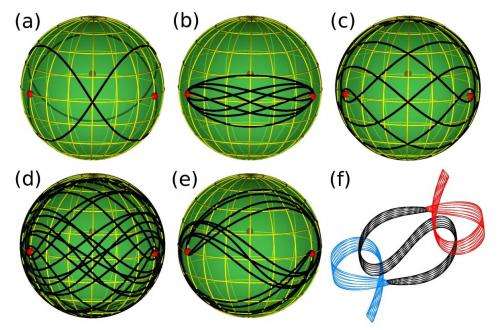March 15, 2013 report
Physics duo discover 13 new solutions to Newtonian three-body orbit problem

(Phys.org) —Physicists Milovan Šuvakov and V. Dmitrašinović of the Institute of Physics, Belgrade in Serbia have discovered using computer simulations, 13 new solutions to the three-body problem—predicting patterns that describe how three bodies will orbit around each other in space in a repeating pattern. The two describe how they came up with their solutions using computer simulations in their paper published in Physical Review Letters.
When two bodies in space orbit one another, such as a planet and a star, their paths can be easily described by Newton's laws of gravity—they are elliptical. When another body is introduced, however, things become so complex that scientists have not been able to find a way to predict the sorts of patterns that are possible for a stable system (where they don't run into one another eventually) to come about. Until now, just three families have been identified: The Lagrange-Euler, the Broucke-Hénon, and the figure-eight.
To discover a repeating pattern that describes how three bodies will orbit one another in stable fashion requires some degree of luck, the Lagrange-Euler family for example was discovered by the mathematicians for whom it is named and is demonstrated by the way the sun, Jupiter and the asteroid Trojan orbit one another. Another way requires some degree of brute force—that's the approach taken in this new effort. The two researchers started with a known solution then changed some of the parameters in their computer simulations and ran the results to see what would happen. As it turned out, their way resulted in the discovery of 13 new families of patterns—stable orbits that eventually lead to all three bodies existing in the same place as they were when the simulation started.
Because they found so many new solutions, the two came up with a way to classify them using what they call a shape-sphere to graphically show what the orbits look like and then gave each a name, based on what they thought they resembled: yarn, butterfly, goggles, etc.
Thus far, the 13 new families haven't been tested thoroughly enough to verify that their orbits would remain stable over long periods of time (which would mean holding their pattern despite slight perturbations), however—the researchers plan to do just that as part of their next effort. If it turns out some or all of them can withstand the test of time, then scientists can begin looking for instances of them in real systems and perhaps learning more about those systems as a result.
More information: Three Classes of Newtonian Three-Body Planar Periodic Orbits, Phys. Rev. Lett. 110, 114301 (2013) DOI:10.1103/PhysRevLett.110.114301 (on ArXiv)
Abstract
We present the results of a numerical search for periodic orbits of three equal masses moving in a plane under the influence of Newtonian gravity, with zero angular momentum. A topological method is used to classify periodic three-body orbits into families, which fall into four classes, with all three previously known families belonging to one class. The classes are defined by the orbits' geometric and algebraic symmetries. In each class we present a few orbits' initial conditions, 15 in all; 13 of these correspond to distinct orbits.
Journal information: Physical Review Letters
© 2013 Phys.org




















